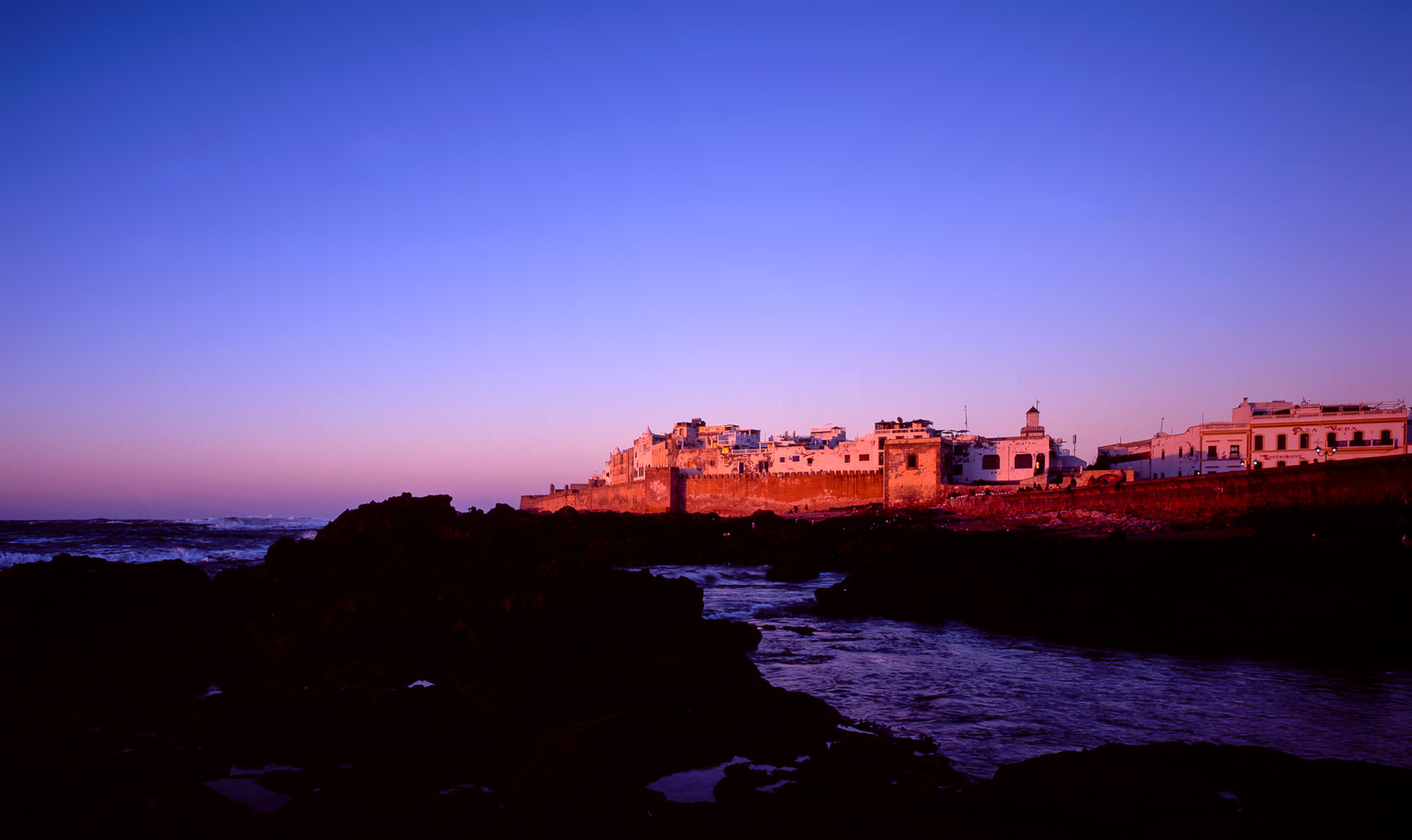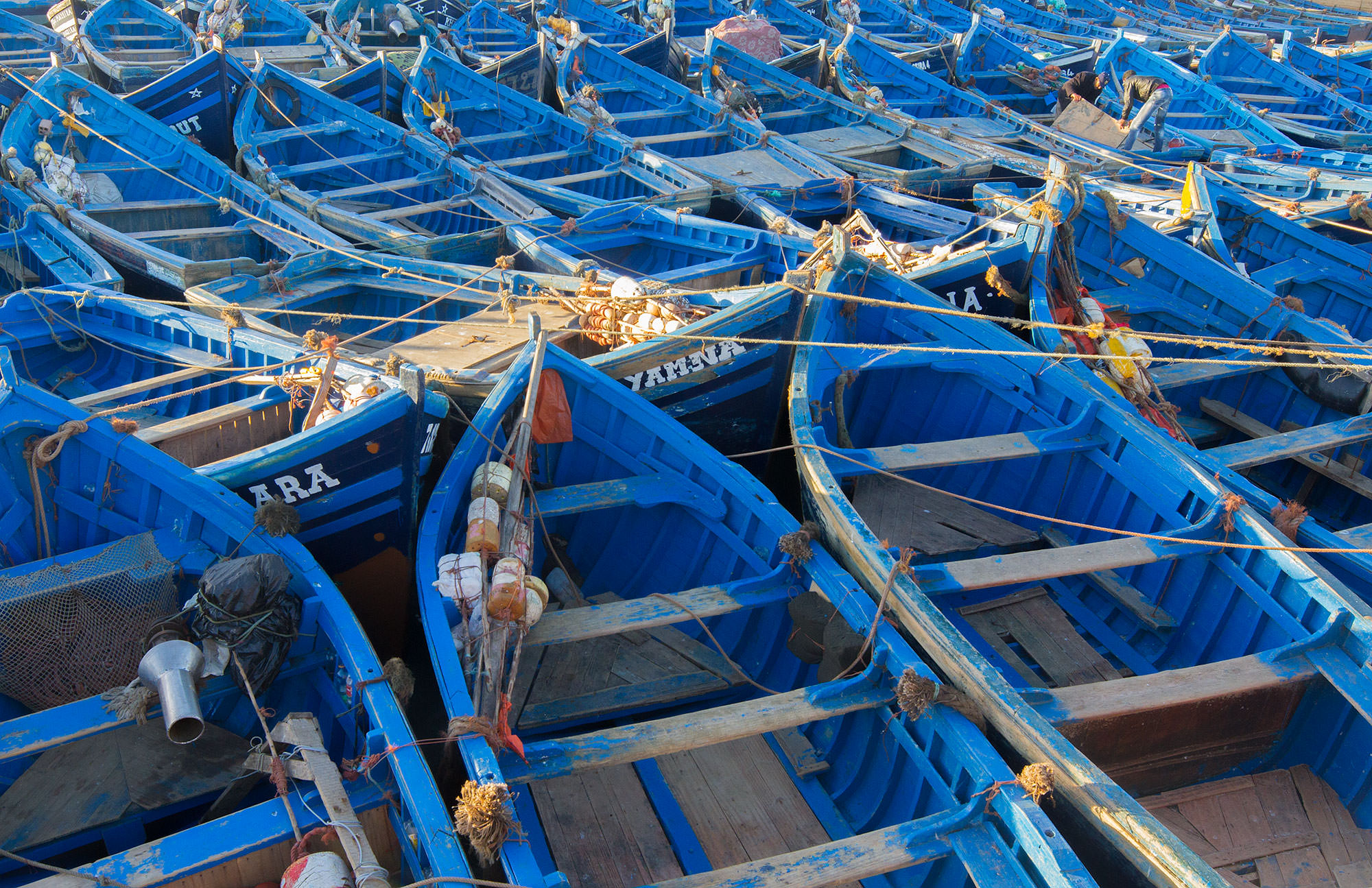The Dry World

The Essaouira
Murex
Notes on travel to Morocco's Atlantic coast city of Essaouira, where I explore the Jimi Hendrix fable and the historical blue dye everpresent in each back alley.
“Water is life,” Hicham says while we eat barbecued fish on a coastal boardwalk in the fortress town of Essaouira. “When Europeans come to Morocco, they are coming for all the sunshine. But here in Morocco, we celebrate the day when it rains. That is when everybody here is the happiest. In Morocco, rain controls the economy. If you don’t have enough rain, everybody suffers.”
The sky over the Atlantic coast is a deep blue, with only a few wispy, white clouds. If in Marrakech, the people find inspiration for their color palette in the sandstone hues of the desert and mountains, then in Essaouira, it is the sky and ocean, for Essaouira is a city of whitewashed walls and blue-painted shutters.
On some doors, where the paint is scuffed down to the bare wood, you can see the history of the door: one decade painted ultramarine, the next, azure, and then maybe majorelle or cerulean; but it is blue all the way through, and the effect, of all this blue and white, against a blue sea and a blue sky, is of an enchanted sky fortress, disconnected from Earth.
But the blue paint is more connected to the sea than the sky, as is all of Essaouira’s history. The city sits right on the coast, facing out from a moon-shaped bay, which is protected by the Purple Islands. These islands shield the bay, and Essaouira, from the open sea.

Pedestrian lane in Essaouira.
The Purple Islands have always dictated the importance of the area. By 1,000 B.C., after two thousand years of use of the area by indigenous Berber fishermen, Phoenician traders set up trading villages, and were lured by the presence of murex shells, which contained glands of pigmented mucus.
The pigment made of murex shells harvested in the Mediterranean and beyond is usually called Tyrian purple - reddish purple, rare and expensive throughout the ancient world, and sought after by the great rulers of the Old World. When you see a deep reddish-purple, and it reminds you of royalty, remember that it's just murex mucous. There is something I find repulsive about that shade of purple. It's the color of pseudo-pretentiousness. And I think humans are repulsed by it for biological reasons. Reddish-purple is the color of spoiled flesh rotting in the sun.
This is not the murex purple of Essaouira. The murex shells of the Purple Islands are not reddish-purple at all. These beautiful Hexaplex trunculus murex mollusks produce a range between indigo, royal blue and bluish-purple, and the hue is known today as Phoenician purple after the traders built production facilities on the Purple Islands. The blues we see today honor the history of the city's three-thousand year relationship with the Murex.

The blue fishing boats of Essaouira.
And it is that color, inspired by the city's three thousand years of murex production, that you see throughout the city. A lovely bluish purple, painted even on every wooden boat that fishes the Purple Islands each morning.
After lunch, we drive to a small town at the southern end of Essaouira Bay, looking for access to the Oued Ksob River. For much of the last thirty years, the lone cafe in Diabat has been successful in propagating a story of how Jimi Hendrix lived here for some time in the 1960's, writing his famous songs on the beach.
Out beyond the high tide mark on the beach, a ruined 18th century watcher lies, like a fallen sandcastle. This, Moroccans from the area will exclaim, was the inspiration for Hendrix's Castles Made of Sand. The purple Murex dye, of course, was the inspiration for the psychedelic anthem, Purple Haze.
Hotels throughout the country claim that he stayed there, and in Essaouira, his presence is felt on the busier streets, in various forms. A rumor says that Hendrix wanted to buy the entire town of Diabat. Another states that he was in the planning stages of purchasing Mogador Island, the largest of the Purple Islands, but the Moroccan Government was forced to stop the sale. Others claim that he was working on turning Diabat into a commune with the help of Cat Stevens and Bob Marley. He fathered many Moroccan children, and also wanted to adopt a young Moroccan boy and bring him to Seattle. While he was in Morocco, he drove around in a hippie van and met up with Timothy Leary.

Blue shuttered windows in the walled city of Essaouira.
Jimi Hendrix did visit Essaouira once, for a day or two. He stayed in a luxury hotel with a friend, but he never wrote songs here, and certainly never visited dusty Diabat.
We park the car on a bridge over the Oued Ksob and walk out through a series of improvised trails toward the mouth of the river. These river mouths in the desert, with their still water and wide clay mud flats, are magnets for birds, and today, a Red Kite floats in the sky above us, Mediterranean warbler species abound in the thickets, and several species of sandpipers are in the river marshes. Closer toward the beach, we see stilts, terns and gulls. From here, we can see the ruined watchtower, the Purple Islands and the whitewashed walls of Essaouira.
I don't think Hicham has ever looked at birds through binoculars before, but it's a reward to see him in his skinny black jacket, fashionable black pants and black dress shoes investigating a handful of Spoonbills.
After the sun sets, and the blue hour sets over Essaouira, we drive the desert road back to Marrakech. It is amazing how quickly the stars become visible at night here. It extends that feeling of Essaouira being a sort of floating fortress, off on its own. The road is a straight one through rocky desert, so for much of the drive there is just black below, and lights above.
“What is the relationship between Morocco and the other Muslim and North African countries?” I ask Hicham. “They love us,” he says. “It is true that we have some problems with Algeria. But it is a problem with their government, not the people. We love the Algerian people. And everybody sees Morocco as the symbol for liberty. They love our liberty."

We picked our lunch from an array of seafood caught that morning.
This was how I had perceived Morocco as well; as a special exception within the Muslim states; as a progressive model for the rest of the Dry World. A country that, far from the epicenter of places like Saudi Arabia, had developed its own distinctly laid-back culture.
Freedom of the press, female politicians, secular political parties. This exception interested me keenly, particularly because of its relationship to my own state. I explain this to Hicham. "I see Morocco as being like what Oregon is to the United States. Both sit in the northwest corner and face out across a large ocean. Oregon is thousands of miles from Washington D.C. and New York City. You are thousands of miles from Saudi Arabia. Both have a band of green along the coast, but the interior is dry, largely unpopulated desert. Both are very rural and blue-collar. But both capture the hearts of their region." I tried to describe Carrie Brownstein and Fred Armisen, playing various Oregon stereotypes, and suggested that Morocco would be that place in an Islamic sketch comedy.

A quiet lane in Essaouira leads to a small restaurant door.
As we near Marrakech, we note an increasing number of police checkpoints. Hicham explains the various ways that police, and other government officials, exact bribes. When we pass a grocery store, he explains;
“You see that grocery store. It is a new one, a big one that sells liquor. Here in Morocco, you need a government permit to sell alcohol. So when you sign the contract, you say you will not sell alcohol to Muslims, only to foreigners. But, of course, everybody sells to Muslims. The government comes and says, okay, I know you are selling to Muslims. So, you give us a little something, and everything will be okay. And so, every day, the stores that sell liquor have to pay tips to the government. Of course, lets say an American comes to Morocco. He buys a bottle, and that’s all he needs for the week. The Moroccans come in to the liquor store, buy twenty beers, and tomorrow they are back for twenty more.”
As he tells this story, we come to a police checkpoint and are stopped. The policeman asks if he has the proper paperwork for driving a foreigner. I am not a client, but a family friend, Hicham explains. Nevertheless, he pulls out a variety of paperwork and is asked to go back to the officer's car. As he does this, he whispers to me to see if I can find a 50 Dirham bill. When he returns, I slip him the bill, which he slips to the officer. "All good," he explains, and we race off. "He was citing me for not having a certain document. But that document has nothing to do with us. It's meant for if you are an adult male traveling with an underage woman. It's just his excuse to get a tip."
And then, in the distance, the warm lights of Marrakech.
